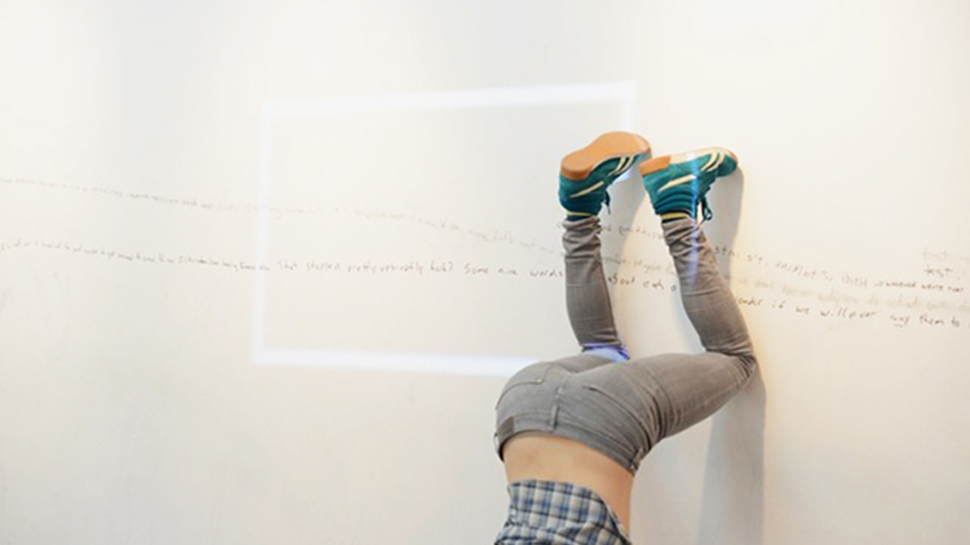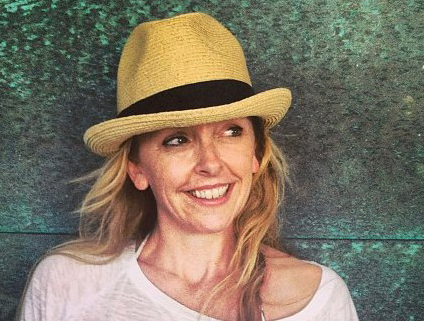Kim Simon (Curator Gallery TPW) and I have been talking on and off about this project and residency for several years. It has been in gentle stages of progress for quite sometime but a lot has developed.
In January 2013 I had the opportunity to come into the TPW R&D space for a week to work on Your Timing is Perfect and Other Wallworks. I had questions, tasks and experiments I wanted to approach with the performers. After the short week we did an invitational showing with a few friends with a brief chat afterwards about the process and the work. That night we did a 45 minute version of the piece. We are working towards a 4 hour version of the work, which would allow for the audience to come and go as they please. There will be another work-in-progress presentation in the months to come, before the actual full and completed performance.
Your Timing is Perfectexplores connection. Connections between performer and viewer, audience and self, us and them, friends and strangers, me and you. It also looks at transforming individuals and their stories into objects, icons, images, portraits, and diagrams. At the base level we were looking at … looking. We were seeing what and how we see. Trying to figure out who we are, and who we are not. We were looking at each other and ourselves. We are looking at presence and absence of the body and gaze in the space. Searching for the banality, brutality and beauty of it all.
It’s been a unique experience for me to work choreographically in a gallery setting. We are really taking the gallery for what it is, and exploring performance in a space that would normally house art, objects, and wall works. We use the walls as walls and physically they become a support, a canvas, and a partner, but they also anthropomorphize into bodies moved by ideas. For the most part the performers stay on the walls, and the viewer is in the centre of the space. The wall divides and unites and helps constitute the boundaries that we explore between the performers and the viewers.
Based on this we performed self and group portraits. We danced, and we didn’t … though, really, it is all dance, even when not moving, as we are bodies in space and time. We talked to each other and to viewers, and (sometimes) viewers talked to us. We played corporate team building and bonding games. We played tennis. We did mind maps, shared our top 10 lists, and shared secrets. Through the process we asked each other about how to explore and experience a work with live bodies in a 360 degree environment, that takes place over an extended period of time. Questions came up:
What effect does the space and time have on the performance and the audience (viewer)? Where should the viewer sit, stand, and be? How should they be? How should we be? How long would they stay? How long can the performance be maintained? How do the performers connect with each other? How do we create certain sections, but keep the piece cohesive?
—
I was slightly reluctant to do a talk-back after the showing. Sometimes that process can be hit or miss mid-creative process. Kim gently pushed me to do it, and reminded me that this was part of the point of the R&D process … talk, discuss, and ask questions! It is important and I think we are, in some ways, still getting better at doing this and making it an integral part of our practice in dance. Or at least, I am. Some people already rock this fully and are leading the revolution.
Conversations:
I had great conversations with all the collaborating artists, and they were all very involved in a lot of the choices and directions of the creation. They really helped define what it is that I am looking for, as well as what we were looking at. Additionally, Kim Simon, Ame Henderson , Justine Chambers, and at times my husband Neville have helped with fluid dramaturgy. Neville mentioned that this piece was taking so long to do that if I were to have an autobiography a chapter will be called The TPW Years. But the pace and the conversations have become part of the process. It is great to have people to talk to about the work who are inside the project, as well as those who are looking in from outside. They ask me questions, suggest readings, ways of talking and looking and seeing. They often see things that I do not, and sometimes miss things that I thought were obvious. A lot of the discussion from that night will help inform the next steps. I think that it helps make the work stronger.
Here are some questions and ideas that came up with the talk back and conversations with my collaborators, Kim, and Ame that night, and afterwards:
Duration: I intend to have different versions of the work (short, medium, and long). The long version could be for up to four or five hours. I am really curious to see how it will translate to an extended period of time. How will the performers deal with possible boredom and repetition. How will they keep it authentic and stay present. How will the audience deal with this? Will they stay or leave and what will they receive from us if they choose the former or the latter? What will we give or receive from them? Do we need to repeat certain aspects every time someone enters the gallery so that they will understand what is going on?
Methodology: I realized along the way that I am not looking to disregard the theatre or the dance within what I am doing in the gallery context. I love theatre! I love dance! But I don’t want to treat the gallery like a theatre or a stage. I worked to strip some parts of the theatricality away. Really I am looking for state over character, and authenticity over performance. But … I want to make some allowances for drama and a slight blurring of the truth in the name of theatre and dance. I like emotion. Life is emotional. My method is not an exact science, but I am not a scientist, and so I am cool with that.
I asked the performers to bring their real selves to the gallery, and from that point we created performances in a collaborative way. We asked ourselves, who are we in reality and in performance? Who are we not? What does our portrait look like? Our bodies hold our stories and our truths, and they are hard to hide.
We try to determine what should be predominant in certain scenes … text or movement … or can they be equal? Does music make the performance more theatrical? We are also thinking about sound vs. music, and how it affects the space and the performance differently.
It is an amazing, eclectic, and intelligent group I am working with. It is also the largest group of people I have worked with in the capacity of director.
Video, Text, and Sound: Jeremy Mimnagh and I have adapted our collaboration and conversations as the ideas changed and grew. We speak about working with video as a lighting source. Video as another or ‘other’ wall. Video representing what is “behind the scenes” or behind the wall. We discuss how much the video image influences the movement and vice versa. How do video and bodies co-exist? What is the role of video/images in the work as a whole?
Spectatorship: The audience for this piece is allowed to ‘break the rules’ of theatre. They are allowed to talk, move, and not pay attention if they choose to do so. This “allowance” is manifested in a variety of ways … the performers interact with them, the setting is a gallery with regular gallery seating (a few benches), there is no official start or ending of the piece, and no barriers in between the audience and the various performances going on at the same time.
We have spent a lot of time wondering if the audience will feel trapped because of this direct connection. They are responsible for their experience (more so than in theatre), especially as they can come and go from the gallery, and respond to varying degrees to the performance. We are also thinking about our responsibility to the audience. How much do we let them know?
Perhaps the audience interaction can continue throughout the performance, or perhaps there are certain moments where that becomes less appropriate. Regardless, we must be ready to roll with what is given to us from the viewers, as we have opened the door to rule breaking.
The size of the space also informs the relationship with the viewer, as we are working in the R&D space, and it is quite small. The proximity of spectator and performer pushes both into a connection, even if just physical to start, just by entering the space. The impact on looking, seeing and facing each other within that restricted structure becomes something with greater potential for intimacy and relation.
Connecting, Looking, Seeing: this work really relies on the audience. Rehearsing without reaction, without the gaze of the audience, is challenging. The looking and the creation or breaking of connection with the audience really informs the performers experience, and is a foundation to the work. In rehearsal we talked about breaking the gaze, but maintaining the relationship. Is it possible? We felt that it was interesting for the performers to enter and exit the relationship with the audience as they saw fit. In some cases the performers looked at each other so long it became uncomfortable, yet with even more time the moment became very moving. The held connection. Elongated attention. Truly seeing each other. Letting people truly see us.
We’ll let you know when you can come see us next at Gallery TPW. And we will hope to see you there.
Jenn Goodwin
With thanks to performers and collaborators Heidi Strauss, Kristy Kennedy, Zoja Smutny, Camilla Singh, Jared MacSween, Luke Garwood, Val Calam, Jeremy Mimnagh. As well as, Kim Simon, Ame Henderson, Justine Chambers, Gary Hall, TPW Staff, Neville Quinlan, Valerie Gelinas, Canada Council for the Arts, The Ontario Arts Council, The Toronto Arts Council, Gallery TPW
And thanks to some good reading along the way:
Sheila Heti, How Should a Person be
Jonathan Burrows, A Choreographer’s Handbook
Jacques Derrida, Memoirs of the Blind: The Self-Portrait and Other Ruins
Dorothea von Hantelmann, How to Do Things with Art – The Meaning of Art’s Performativity










